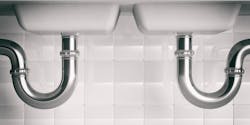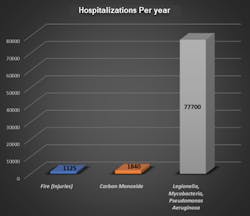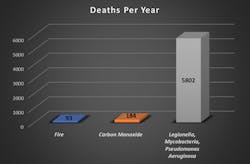Water Management: Missed Opportunities to Promote Wellness, Save Energy and Protect Assets
What is a Truly Healthy Building?
Healthy building initiatives typically address air quality (as they should) but overlook water even though it is responsible for far more hospitalizations and deaths (see figures 1 and 2) based on data provided by the CDC and FEMA and published in the American Journal of Emergency Medicine. Many buildings have sensors installed in ducts to measure particulate matter (PM 2.5), carbon dioxide, carbon monoxide, total volatile organic compounds (TVOC) and humidity but, oddly, have no sensors for detecting or predicting water quality problems. Water quality management is thus a missed opportunity to reduce risk and promote wellness.
Do ASHRAE Standard 188 Water Management Plans Actually Work?
Data from a 2021 study presented May 11, 2022, at the Emerging Water Technology Symposium in San Antonio and published by the Association of Water Technologies in the Spring 2022 issue of Analyst showed that comprehensive ASHRAE Standard 188 water management programs (WMPs), if fully implemented, can effectively reduce Legionella in domestic (potable) plumbing systems, but a shockingly low percentage of facilities are performing WMPs well.
Facilities that had higher control measure compliance (i.e., implementation on schedule) and performed more water quality tests were likely to find Legionella in a lower percentage of plumbing system locations, but only 19% of the 908 WMPs that qualified for the study had control measure compliance greater than 80%.
Moreover, the facilities studied had a WMP in a cloud-based application with comprehensive WMP content. Many of the facilities were part of prestigious institutions or large companies with valuable brands. If the same study were performed on all buildings in the United States, the percentage with greater than 80% implementation of comprehensive WMPs would be infinitesimal.
According to research funded by the Water Research Foundation and published in 2021 by the Association of State Drinking Water Administrators and Association of State and Territorial Health Officials, the percentage of facilities with comprehensive WMPs is likely very low. Only 50% of education and hospitality facility managers surveyed had heard of ASHRAE 188. Awareness was even lower among multi-family facility managers—less than 30% knew that domestic water systems have conditions favorable to Legionella growth or had even heard of water management plans.
In sum, the data indicates that the premise of ASHRAE Standard 188 is sound—implementing comprehensive control measures can reduce Legionella in domestic water. The reality, however, is that a very low percentage of facilities are fully implementing comprehensive WMPs, which is likely why reported cases of Legionnaires’ disease have not decreased since ASHRAE Standard 188 was released.
The CDC, aware of low ASHRAE 188 compliance, has urged states to adopt regulations requiring WMPs. Several states are underway with rules and many more are considering action.
Even with regulations and insurance requirements, what is likely needed to see proper water quality management in most facilities is to make WMPs easier without eliminating important control measures. Adopting technology that automates many mundane tasks is the key to easier yet effective water system management. Automated monitoring, alerts, reporting and documentation will help facilities personnel stay on track and save time. Automation can make WMPs more effective, too. The technology is already available.
What’s In It for Building Owners?
In addition to improving health, safety and wellness for building occupants, proper water quality management can benefit building owners in asset value, reliability, resiliency, brand equity and sustainability.
Improper water system management can have ramifications beyond deadly outbreaks. Taste or odor issues may repulse tenants, employees and visitors. Hotel guests may be dissatisfied because of inadequate hot water temperatures caused by a problem that could have proactively been detected by monitoring and corrected.
Water quality affects heating and cooling efficiencies, and thus energy bills, too. Biofilm increases pumping and electricity costs. Only 2 millimeters of calcium carbonate scale and biofilm can increase energy costs by 50%, according to research by Montana State University.
Water—like bread—can and does “go bad” over time. Stagnant water in a building can not only grow pathogens but become foul in taste and odor, extract metals and destroy building infrastructure through microbial induced corrosion (MIC). According to data published by Microbial Biotechnology in 2021, at least 20% of corrosion is attributable to MIC.
Poorly managed water quality can result in a loss of revenue, major disruptions and a lower building resale value.
What is a Good Starting Point?
Although a comprehensive building water management program will provide the best protection and benefits, facility managers who are not ready to take that step could start with water quality benchmarking. If water quality benchmarking is set up properly, the program can seamlessly be expanded to a full water management program, future-proofing the facility for WMP regulations.
Water quality benchmarking provides data facilities personnel can use to make better water management decisions, more easily. Data can also alert facilities to acute problems (e.g., caused by water main breaks) that could cause disease or damage equipment.
Water quality benchmarking can be applied to one building (internal benchmarking), multiple buildings on a property, or to an owner’s portfolio of properties.
Internal water quality benchmarking makes relevant comparisons between a building’s actual and target water system performance. Robust but easy-to-understand analytics applied to water quality and microbial data obtained from sensors and hand-held devices can expose or predict potential problems before they cause illness or damage, allowing the facility to manage water looking through the windshield instead of the rear-view mirror.
Comparing performance in one building with others on a property provides additional data that can expose potential issues, promote continuous improvement, and utilize predictive maintenance.
Analyzing water quality benchmarking data across a portfolio can reveal best practices for improving reliability and uptime of water-related services and equipment. It can also help in making lifecycle assessments to anticipate when infrastructure might need replacement or divestiture.
If buildings are managed to control water quality as well as air hazards, they can become healthy and smart indeed—protecting life, promoting health, saving water and energy, reducing costs and enhancing brand equity.
About the Author
David Swiderski
David Swiderski is the Senior Technical Strategist at HC Info.
Matt Freije
Matt Freije (BSME, Purdue Univ) is the founder and CEO of HC Info and the content director for LAMPS, its cloud application for water management plans, IoT data analytics, and training. He is a Certified Water Specialist and an ASSE Standard 12080 instructor. He has provided water system management education and information since 1995.


